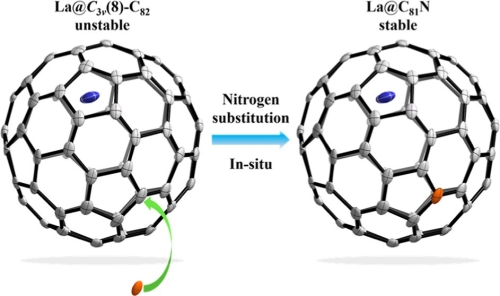
Besides skeletal and exohedral modifications, fullerenes can also be modified endohedrally via encapsulating metal or non-metal atoms, exhibiting unique properties such as single-molecule magnetism. Therefore, to combine the advantages of both types of fullerenes, researchers have been attempting to modify the cage of endohedral metallofullerenes to obtain MEAF. Although previous research has detected ionized MEAF, [La@C81N]+, in gas phase, pristine MEAF has never been synthesized.
Based on previous works on the synthesis and isolation of novel low-stability heterofullerenes, Prof. YANG’s team synthesized pristine MEAF La@C81N by a modified Krätschmer-Huffman DC-arc discharge method and isolated La@C81N by a four-step high performance liquid chromatography (HPLC).
To verify that the carbon cage is an azafullerene, the researchers characterized the molecular structure of La@C81N by single-crystal X-ray diffraction and confirmed that the carbon cage was derived from C3v(8)-C82 with one carbon atom replaced by a nitrogen atom.
Furthermore, they systematically studied the electronic properties of La@C81N by ESR spectroscopy, UV-vis-NIR spectroscopy and electrochemistry, and performed DFT calculations to identify the possible nitrogen substitution site. The results showed that La@C81N exists in a stable monomer form with a closed-shell electronic state, drastically different from the open-shell electronic state of La@C3v(8)-C82.
Therefore, skeletal modification of the fullerene carbon cage could regulate the electronic properties of metallic endohedral fullerenes.
This work tackled the two-decade challenge of synthesizing and isolating pristine MEAF.

Nitrogen substitution of carbon atoms on La@C3v(8)-C82 carbon cage. (Image by XIANG Wenhao et al.)
Jane FAN Qiong
University of Science and Technology of China
E-mail: englishnews@ustc.edu.cn

86-10-68597521 (day)
86-10-68597289 (night)

52 Sanlihe Rd., Xicheng District,
Beijing, China (100864)

